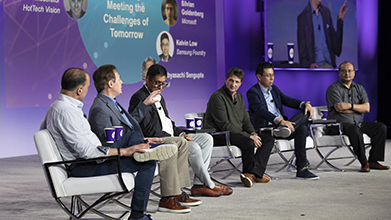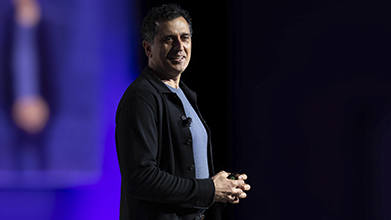Cloud native EDA tools & pre-optimized hardware platforms
As the technological landscape evolves, semiconductors are the backbone behind new, advanced devices, leading to a growing demand for skilled semiconductor engineers. Deloitte predicts the global industry will need to fill over 1 million additional semiconductor jobs by 2030, equivalent to 100,000 jobs annually, making workforce development programs increasingly vital to modernize our society.
The CHIPS Act set a fire under semiconductor companies to ensure education and training programs align with rising industry needs, leading to top companies prioritizing workforce development programs. In addition to properly preparing students for the real world, these programs help diversify and strengthen the workforce, attract more professionals to semiconductor careers, and expand the talent pool to achieve economic goals.
By enabling access to cutting-edge technologies, developing shared programs, and partnering on advanced collaborations, Synopsys Academic & Research Alliances (SARA) is helping to fulfill the industry’s needs by supporting universities to build a diverse semiconductor workforce ready to invent the technology of the future. SARA’s University Software Program enables academic institutions to access cutting-edge technology, training, and classroom materials to advance their education and fundamental research with the intent to prepare highly skilled graduates. Synopsys also recognizes the driving force of researchers in the semiconductor industry and has formed research alliances with key universities.
Spanning several regions, Synopsys has passionate individuals spearheading each program and partnership to drive the industry forward by educating professors, industry professionals, and students. Read on to learn more about SARA’s workforce development activities.

National Yang Ming Chiao Tung University (NYCU) and Synopsys signed a memorandum of understanding to establish the NYCU-Synopsys EDA/AI Research Center, one of many examples of collaborative workforce development efforts between academia and industry.
Addressing the Demand for Semiconductor Talent Across Different Regions
The supply and demand for talent is a growing obstacle.
“There are two issues here. One is quality and the other is quantity. Thanks to artificial intelligence and machine learning, technology has been developing so fast that universities face challenges educating students [to equip them] with knowledge and skills to meet evolving industry standards. In terms of quantity, the demand for semiconductor talent is multiplying around the world,” says Anna Hsu, senior program manager, who oversees SARA in the Taiwan, Middle East, and North Africa (MENA) regions.
In Taiwan, Synopsys has fostered relationships with government entities to help fund academic programs and support industry research as well as introduced the successful Purple 100 Program. This program trains around 100 participants annually, helping users become familiar with front-end and back-end design and job-matching students to customers once certification is complete. Another example of industry/academia collaboration in Taiwan took place on March 29, 2024, when National Yang Ming Chiao Tung University (NYCU) signed a memorandum of understanding with Synopsys to establish the NYCU-Synopsys EDA/AI Research Center to foster co-innovation and advancement of semiconductor and AI technologies. Through this collaboration, Synopsys and the university aim to build an advanced simulation and IC design environment with smart/AI digital twin capabilities to enrich the teaching and hands-on research and design experience for students.
Over in Armenia, the Synopsys team predicted the need for industry education far ahead of other leading semiconductor companies. They developed the Synopsys Armenia Education Department, a workforce development initiative that started over two decades ago to develop a well-rounded curriculum in IC design and EDA for both bachelor’s and master’s programs. Patrick Haspel, the global director of SARA, described the program as essential in comparing the current curriculum with the skills required:
“We’ve partnered with Armenian universities to develop lecture material and labs for professors to use in the classroom to close the skill gap. It’s impressive to see the outcome and how these labs are now being used and made available to classrooms globally.” —Patrick Haspel, Global Director of SARA
 EDA Specialization Course Plan for Synopsys Armenia Education Department
EDA Specialization Course Plan for Synopsys Armenia Education Department
Over in India, the talent gap is an opportunity to introduce fresh faces to the industry while increasing adoption of Synopsys technology. “With more students learning and using Synopsys technology, it reduces the training and upskilling cost for our customers as well as increases the support that our customers look for. Obtaining good talent for Synopsys and the ecosystem will become easier as adoption of SARA curriculum and support will help students become industry ready,” says Sankalp Singh, University Program manager for the SARA India region.
While India is known as a powerhouse in design, the SARA program helps give the region opportunities to be part of the end-to-end solution as well. “Now is the right time to go after the bigger picture,” said Singh. “In India, we’re taking a holistic approach and have added close to 30+ institutions and started working with them on curriculum review and enhancement.”
Additionally, our relationship with the Indian Institute of Technology (IIT) Bombay, one of India’s premier technology institutes, has resulted in our sponsorship of the Synopsys Semiconductor Lab for Virtual Fab Solutions, for which we are providing course content, training, and hardware and software. The lab will be available by the end of the year and provide students opportunities to learn about process technologies, materials, and device architecture, with the aim of workplace readiness in the semiconductor industry upon graduation.
The image below shows executives from IIT Bombay and Synopsys celebrating the recent inauguration of the lab at the IIT Bombay campus in Mumbai, India.

“Boot camps are among the best resources to help students prepare for the market. The Synopsys IC design boot camp is well-known among engineering faculties and students across the region, where we collaborate with universities and engineers to provide information on Synopsys tools and IP. Many of our current employees applied to Synopsys after participating in a boot camp,” says Victor Grimblatt, R&D group director in the EDA Group at Synopsys, who has partnered with universities across nine countries. Grimblatt, based in Chile, believes that creating more interest in semiconductor professions starts with sharing more in-depth knowledge about the market.
In addition to the boot camps, the Latin America SARA program has also signed collaborative alliances with seven universities to fill curriculum gaps by developing courses in digital IC design, R&D, and more. The region has also established an internship program with the Advanced Center for Electrical and Electronic Engineering, which seeks to contribute to the development of the microelectronics market while generating knowledge in the use of Synopsys tools.
Paving the Way Toward Accessible Education
The industry is constantly changing and becoming more advanced every day. To address the talent gap, we must work together to ensure university curriculums can keep up with this evolution and that more students are trained in EDA tools from the beginning of their education to reduce the learning curve when they enter the workforce. These programs are also a great way for professionals to give back to society and their alma mater by helping and supporting the next generation as they become part of the semiconductor industry.
Combining in-person workshops by Synopsys employees, hands-on resources, and training in Synopsys tools, there’s no doubt that SARA programs are making a positive global impact. Cata Fielder, communications specialist for SARA Latin America, noted, “Students are thrilled because it is their first approach to the ‘real world,’ and professors see the programs as a great opportunity for Synopsys tools to be amplified in different regions.”
Synopsys is proud to be part of the ecosystem of industry players, governments, and academic institutions coming together to bridge the gap between supply and demand for skilled engineers worldwide. We’re eager to expand our partnerships further and reach even more regions to inspire and foster the next generation of technologists and innovators, wherever they may be.









